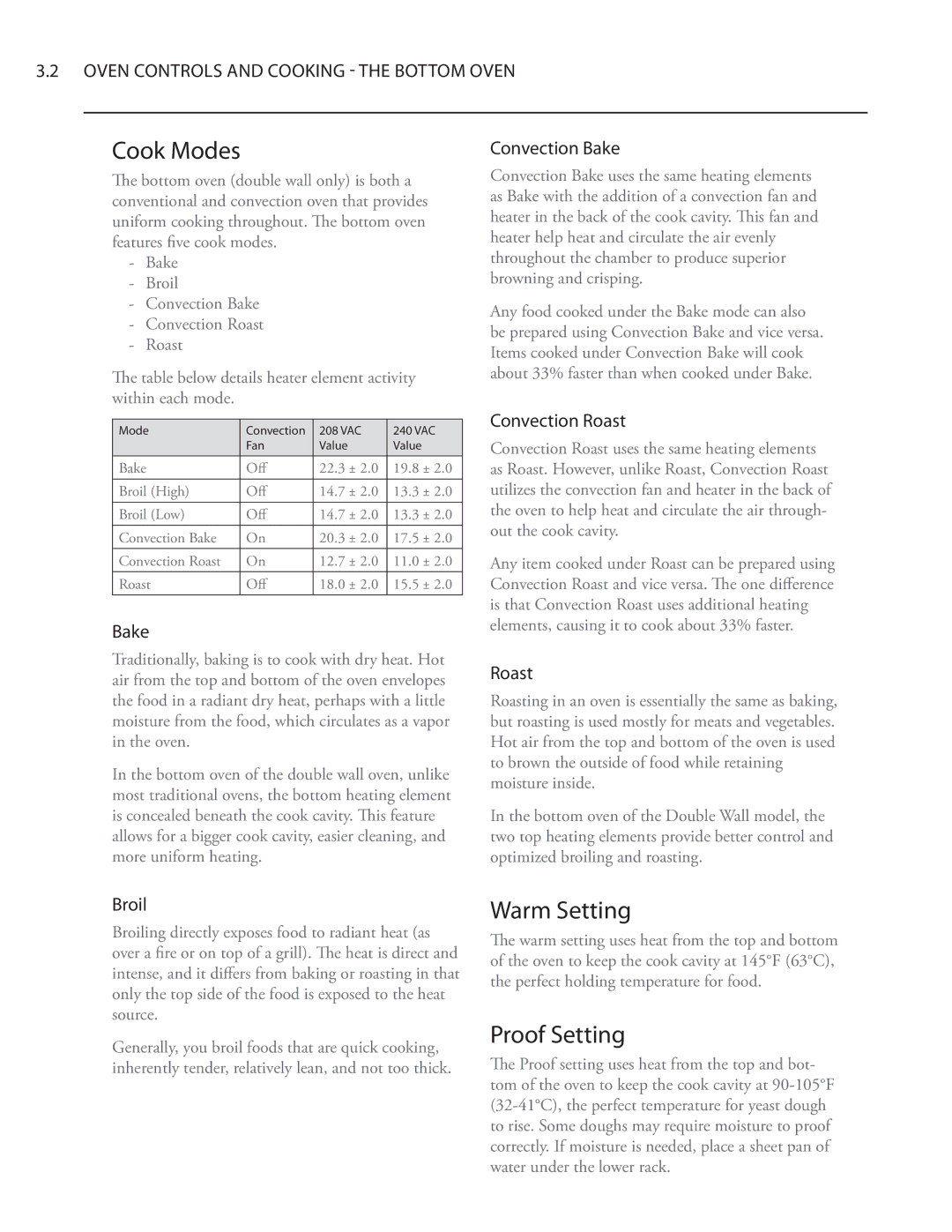
3.2OVEN CONTROLS AND COOKING - THE BOTTOM OVEN
Cook Modes
The bottom oven (double wall only) is both a conventional and convection oven that provides uniform cooking throughout. The bottom oven features five cook modes.
-Bake
-Broil
-Convection Bake
-Convection Roast
-Roast
The table below details heater element activity within each mode.
Convection Bake
Convection Bake uses the same heating elements as Bake with the addition of a convection fan and heater in the back of the cook cavity. This fan and heater help heat and circulate the air evenly throughout the chamber to produce superior browning and crisping.
Any food cooked under the Bake mode can also be prepared using Convection Bake and vice versa. Items cooked under Convection Bake will cook about 33% faster than when cooked under Bake.
Mode | Convection | 208 VAC | 240 VAC |
| Fan | Value | Value |
|
|
|
|
Bake | Off | 22.3 ± 2.0 | 19.8 ± 2.0 |
Broil (High) | Off | 14.7 ± 2.0 | 13.3 ± 2.0 |
Broil (Low) | Off | 14.7 ± 2.0 | 13.3 ± 2.0 |
Convection Bake | On | 20.3 ± 2.0 | 17.5 ± 2.0 |
Convection Roast | On | 12.7 ± 2.0 | 11.0 ± 2.0 |
Roast | Off | 18.0 ± 2.0 | 15.5 ± 2.0 |
Bake
Traditionally, baking is to cook with dry heat. Hot air from the top and bottom of the oven envelopes the food in a radiant dry heat, perhaps with a little moisture from the food, which circulates as a vapor in the oven.
In the bottom oven of the double wall oven, unlike most traditional ovens, the bottom heating element is concealed beneath the cook cavity. This feature allows for a bigger cook cavity, easier cleaning, and more uniform heating.
Convection Roast
Convection Roast uses the same heating elements as Roast. However, unlike Roast, Convection Roast utilizes the convection fan and heater in the back of the oven to help heat and circulate the air through- out the cook cavity.
Any item cooked under Roast can be prepared using Convection Roast and vice versa. The one difference is that Convection Roast uses additional heating elements, causing it to cook about 33% faster.
Roast
Roasting in an oven is essentially the same as baking, but roasting is used mostly for meats and vegetables. Hot air from the top and bottom of the oven is used to brown the outside of food while retaining moisture inside.
In the bottom oven of the Double Wall model, the two top heating elements provide better control and optimized broiling and roasting.
Broil
Broiling directly exposes food to radiant heat (as over a fire or on top of a grill). The heat is direct and intense, and it differs from baking or roasting in that only the top side of the food is exposed to the heat source.
Generally, you broil foods that are quick cooking, inherently tender, relatively lean, and not too thick.
Warm Setting
The warm setting uses heat from the top and bottom of the oven to keep the cook cavity at 145°F (63°C), the perfect holding temperature for food.
Proof Setting
The Proof setting uses heat from the top and bot- tom of the oven to keep the cook cavity at
